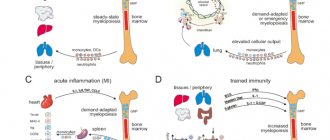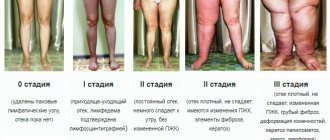Numbness in the upper extremities is a fairly common phenomenon; both children and adults have encountered such sensations. Cases when the thumb on the right hand goes numb equally indicate that the person, for example, has been working at the computer on the keyboard for a long time, and that pathology is developing in the body.
There are therapeutic and preventive complexes that can minimize pain and tingling. Before choosing a list of procedures or making an appointment with a neurologist, you need to clearly understand the reasons why the middle finger on your right hand or the rest goes numb.
Sources of development of the problem
Doctors distinguish two main subgroups of causes of discomfort. Particular attention is paid to diseases, under the influence of which the fingers on the upper extremities began to go numb.
Physiological causes of deviation
Non-standard symptoms do not always serve as evidence of the development of a pathological process. Common reasons include:
- Uncomfortable position during night rest - due to weight pressure on the limb. At first it tingles in the palm area, later it swells. Statistical posture provokes pain throughout the arm, up to the elbow and above.
- Wearing tight clothing with tight sleeves and cuffs can cause circulatory dysfunction in both upper extremities. Rings, bracelets, watches delivered overnight interfere with the free circulation of blood through the phalanges and hands.
- Deformation - bumps, dents on the bed provoke discomfort in the morning. If after waking up your arm hurts or your pads go numb, then you need to replace your old mattress with an orthopedic one.
Spending a long time at the computer or office desk also negatively affects the sensitivity of the fingers. The solution to the problem is to perform gymnastics for the upper limbs - every hour for 5 minutes.
Pathological causes
There are a large number of diseases that can lead to numbness in the fingers. Common causes include pathologies of the musculoskeletal and cardiovascular departments.
Cervical osteochondrosis
A disease characterized by degenerative-dystrophic changes in the cartilaginous tissues of the joint. Damage to the cervical spine leads to damage to the nerves going to the upper limbs. Periodic loss of sensation in the fingers is observed on one of the hands - right or left.
Depending on the location of the damage, the following manifestations occur:
- at the level of the 8th vertebra - ring finger and little finger;
- at the 7th vertebra - middle and nameless;
- at the 6th vertebra - large, index and middle.
Combined sensory loss in the lower and upper extremities is rare. Cold hands in hot weather are a sign of circulatory problems.
Carpal tunnel syndrome
The pathology leads to pinching of the median nerve in the wrist. Symptoms appear:
- swelling of the fingers;
- pain syndrome of varying severity.
A severe form of pathology prevents the patient from engaging in daily work. A person may drop small and medium-sized objects from their hands and have difficulty moving their fingers.
The disease occurs in people who have been in a statistical situation for a long time.
Strong tension in the hands provokes poor circulation, congestion, and pinched nerve endings. Patients are recommended to do short warm-ups every hour to normalize blood circulation.
Polyneuropathy or polyneuropathy
The condition occurs when the nerve endings in the hands of the upper extremities are damaged. The severity of symptoms depends on the degree of damage: unpleasant sensations can be observed in the fingertips several times a week or constantly. Lack of treatment leads to complete loss of sensation at the tips of the phalanges. Pathology is formed under the influence of vitamin deficiency, infectious diseases, and diabetes.
Raynaud's disease
The developing disease leads to disturbances in blood circulation in the small vessels of the hand. When going out into the cold, patients freeze, their fingers cramp, and they often catch a cold. People with Raynaud's disease must be careful when in contact with cleansers, detergents, and water - all work must be done with household gloves.
Arterial and venous thrombosis
It is characterized by blockage of blood vessels with blood clots, followed by dysfunction of the circulatory system. A lack of nutrients and oxygen causes the fingertips to go numb. As the pathology develops, loss of sensitivity spreads to the entire upper limb, and discomfort increases.
The presence of symptoms for more than 2 hours requires contacting a medical facility - delay threatens tissue necrosis.
Patients who ignore the signs of thrombosis for a long time, in severe cases, have their limbs amputated.
Cerebral vascular insufficiency
Lack of tactile sensation may indicate an impending stroke. The pathology affects one arm, the condition is accompanied by attacks of headaches and increased blood pressure. Lack of professional help can cause death.
Why does the little finger on my right hand always go numb?
A common culprit in the development of numbness in this case is overexertion. Most people are right-handed, and carpal tunnel syndrome occurs on the right side. Compression of the median nerve occurs in seamstresses, programmers, and sign language interpreters, whose work involves small, monotonous movements.
In second place is cervical osteochondrosis, in which most often the little and ring fingers on the hand go numb . Inflammation of the spinal root leads to disruption of the innervation of the upper limb.
The third is vascular disorders. This is a blockage of the lumen of small vessels by a thrombus, cholesterol plaque (with atherosclerosis), spasm.
On the fourth - damage to the ulnar nerve due to neuritis.
Other root causes of paresthesia:
- fresh and old injuries;
- metabolic disorders;
- hypo- and vitamin deficiencies;
- neoplasms.
Other reasons
If your fingers go numb, then the problem may be associated with other abnormalities in the functioning of the body:
- Rheumatism
- leads to damage to muscle and joint tissues, the cardiovascular department. Accompanied by severe pain and aching fingers. - Endocrine pathologies
- cause rapid weight gain, inflammatory processes in the lymph nodes, and deterioration in health. - Arthrosis and arthritis
- attempts to move the fingers lead to pain. Patients experience swelling and changes in the shape of the phalanges. - Injuries
- bruises, fractures and errors during surgery provoke a deterioration in the functioning of the circulatory department. Old traumatizations can remind themselves when weather conditions change.
A diagnostic examination will help determine the initial source of deviation in pregnant women. Predisposing factors include kidney dysfunction, pinched nerves in the spine, carpal tunnel syndrome, iron deficiency anemia, or insufficient intake of vitamins and minerals.
When is surgery needed?
There are a number of situations when conservative therapy does not allow one to get rid of the numbness in the fingers and other symptoms that bothers the patient, or the disease that provokes it poses a serious threat to the life and health of a person. In such cases, patients are recommended to undergo surgical intervention, the nature of which directly depends on the type of pathology detected.
So, the operation could consist of:
- removal of peripheral nerve tumors;
- neurolysis;
- decompression of compressed nerve structures;
- performing nerve plastic surgery for traumatic injuries;
- removal of cervical ribs;
- removal of aneurysms;
- removal of intervertebral hernias, etc.
Peripheral nerve tumor removal
This operation is required when benign or malignant tumors are detected that compress the peripheral nerve trunks. In the first case, it can be carried out by blunt desquamation from a capsule formed by connective tissue. Sometimes it becomes necessary to remove the damaged nerve fragment, after which it is repaired or sutured.
If fingers become numb as a result of the formation of neurofibromas, especially with multiple neurofibromatosis, surgical intervention is indicated only in cases where this benign neoplasm compresses the nerve trunk. This is due to the fact that the removal of one of the tumors can become an impetus for the formation of others, which can complicate the patient’s condition.
When diagnosing cancerous tumors, the operation involves removing the entire tumor, including healthy tissue and nearby lymph nodes. After this, patients are prescribed radiation therapy.
Neurolysis
Neurolysis or release of the nerve from the surrounding connective tissue scar tissue is used for:
- injuries of various types that caused nerve damage;
- compression of the nerve trunk by scar tissue;
- compression of the nerve by an aneurysm;
- failure of the nerve suture.
The goal of the operation is to restore normal nerve conduction. Therefore, it can act as a separate type of surgical intervention, or be only one of its stages.
Decompression of nerve trunks
This operation is performed when carpal tunnel syndrome develops as a result of compression of the nerve in the musculoskeletal canal of the wrist, etc. It is used when pain in the hand persists and there is a significant risk of developing muscle atrophy. The essence of this type of surgical intervention is to dissect the tissue that is compressing the nerve, and sometimes to move the nerve itself, followed by restoration of the anatomy of the musculoskeletal canal.
Plastic surgery and suture of nerve trunks
A nerve suture or neurorhaphy is required when the nerve trunk is ruptured as a result of a traumatic factor or after resection of its fragment during surgery. The essence of the method is the precise comparison of cross sections of the dissected nerve, followed by suturing its sheath or individual bundles.
Nerve repair is indicated when it is impossible to apply a suture due to the remote location of the remaining ends. It consists of using grafts taken from the patient’s other superficial nerves innervating the skin and using them to connect the remaining fragments of the injured nerve trunk. The autograft is fixed with sutures.
Removal of cervical ribs
If the fingers become numb due to the presence of an additional rib at the cervical vertebra, it is recommended to remove it in parts, but entirely along with the periosteum. For this purpose special forceps are used.
Aneurysm removal
The operation can be performed using different techniques, the choice of which directly depends on the location of the aneurysm:
- installation of a vascular stent or coil;
- applying a clip at the base of the aneurysm neck.
Removal of intervertebral hernias
Operations of this type are performed when fingers become numb as a result of the formation of protrusions or hernias in the intervertebral discs of the cervical spine. They can be carried out in different ways, including by:
- hydroplastics;
- nucleoplasty;
- endoscopic hernia removal;
- microsurgical operation.
In all cases, by removing the protrusion of the disc, decompression of the spinal root responsible for the innervation of the arm and fingers is carried out.
Thus, numbness of the fingers can be either a harmless situation, or be a consequence of an injury, or indicate the development of quite dangerous diseases, including the spine. Therefore, when this symptom appears, it is important not to hesitate and immediately contact a neurologist or spinal surgeon.
Diagnostic measures
When visiting a clinic, the patient is referred to a therapist. The doctor collects anamnesis, asks about symptoms, their frequency, duration. After a preliminary diagnosis has been made, the patient is given directions for diagnostic examination:
- Dopplerography
- necessary to determine the patency of arterial and venous vessels; - MRI or CT
— allows you to identify degenerative changes in the cervical spine: vertebrae, soft tissues and nerve fibers; - electroencephalography
- carried out to assess brain activity, oxygen saturation of the main arteries; - echoencephalography
- determines structural changes in parts of the brain; - X-ray images
- helps to identify deviations in cartilage discs, compression of blood vessels, nerve endings.
Suspicions of problems in the cardiovascular department are confirmed by ultrasound and electrocardiogram. They are necessary for symptoms of pre-infarction and pre-stroke conditions.
Diagnostics
Determining the cause of numbness in the fingers is carried out by neurologists. The initial stage of the examination includes a survey, general and neurological examination. The specialist evaluates the appearance of the hand, determines the pulsation of the arteries, examines reflexes, and asks the patient to perform various movements to identify motor disorders. As part of further examination, the following are prescribed:
- Electrophysiological methods
. Electroneurography and electromyography help confirm damage to the nerve trunks, determine its level, extent and severity of the pathological process. - Radiography
. X-ray examination of various parts of the upper limb is prescribed taking into account the nature of neurological disorders, ENG and EMG data indicating the level of damage. The images reveal bone deformations, tumors originating from cartilage and bone tissue, and degenerative changes. - Angiography.
Contrast studies of blood vessels are recommended for signs of Raynaud's syndrome. The method confirms the violation of the uniformity of the lumen of the arteries, the absence of collaterals, and an insufficient number of capillaries. - and MRI.
Performed for suspected diseases and injuries of the spinal cord or brain. They help clarify the location, size and nature of the pathological focus. - Lab tests
. During laboratory diagnostics, specific markers of rheumatic diseases, signs of anemia and hypovitaminosis are determined.
Electroneuromyography
Treatment of hand numbness
After determining the developing disease, the doctor selects a suitable treatment regimen. If your hands become numb, they begin to be treated with medications, gymnastic exercises, and physiotherapeutic procedures. The key goals of therapy are:
- relief of inflammation and swelling;
- suppression of pain, muscle spasms;
- normalization of blood circulation in the hands and body.
Drug therapy is selected taking into account the general condition, age of the patient, and the complexity of the pathological process. Folk remedies in most cases are not sufficiently effective.
Medicines
If the function of the cardiovascular system is impaired, patients are prescribed vasodilators Osmo-Adalat, Kordipin-retard, Phenigidine. Reducing the level of blood density, improving local blood flow and enriching with oxygen is carried out with Vazonit, Pentoxifylline, Trenpental.
For osteochondrosis, intervertebral hernia, inflammation in the wrist area, therapy begins with NSAIDs: Ibuprofen, Nise, Diclofenac, Indomethacin.
The patient is prescribed analgesics - Analgin, Baralgin, Tempalgin and muscle relaxants - Mydocalm, Sirdalud, Tolperisone.
Local medications are used to relieve discomfort in the fingers - Fastum gel, Diclofenac, Voltaren. Multivitamin complexes increase the activity of the immune system and compensate for the lack of useful substances: Alphabet, Complivit, Vitrum, Centrum, special Merz dragee.
Why does the little finger on my left hand go numb?
Paresthesia on the left requires special attention. They can be a sign of cardiovascular pathologies: angina pectoris, myocardial infarction and stroke. These conditions are accompanied by concomitant symptoms, but there are also isolated cases when only the little finger on the left hand goes numb , and then the clinical picture unfolds.
Etiological factors also include osteochondrosis, local ischemia and other pathologies listed for the corresponding finger on the opposite side.
Preventive actions
Prevention of the development of conditions and diseases leading to loss of sensitivity in the fingers and hands includes recommendations:
- The right choice of clothing - items with narrow sleeves are excluded from the wardrobe. Gloves must be made without synthetic additives and must not pinch fingers.
- When working with a monotonous hand position, gymnastic exercises are recommended. They are carried out every hour, for five minutes.
- Getting rid of alcohol and nicotine addiction - both bad habits provoke vasoconstriction and poor blood circulation. Physical activity, lifting heavy objects and carrying a bag on the fingers of one hand should be supervised.
- Changing the usual diet - healthy elements should predominate in the products, especially subgroup B vitamins. The daily menu includes fermented milk products, liver, chicken eggs, seafood, and fish.
- Any inflammatory and infectious diseases should be treated in a timely manner. Joint damage can result in arthritis.
Changes in your work and rest schedule - getting enough sleep, breaks from work, long walks in the fresh air and reasonable exercise will help prevent problems with blood flow in the upper extremities.
What is the body saying?
Suddenly my fingers lost sensitivity. If this is a rare phenomenon and it disappears after 2 - 3 minutes, then there is nothing to fear. If such sensations bother you often, then this is a signal of a developing disease.
- Little finger. Paresthesia indicates chronic heart failure and other cardiac pathologies.
- Forefinger. Goes numb with diabetes, occupational stress, inflammation in the joints.
- Thumb. Metabolic processes in the spine are clearly disrupted. You may feel pain in the forearm and weakness in the arm muscles.
- Middle finger. Raynaud's disease, hernia, articular deformity, osteochondrosis of the 7th vertebra.
- Nameless. Numbness due to the fact that the nerve endings in the bend of the elbow are compressed.
General information about pathology
Incomplete tactile sensitivity, a feeling of periodic tingling in the phalanges may indicate pathologies of various internal systems and organs.
Dystrophic-degenerative changes in the spine, various injuries, and osteochondrosis can cause numbness not only in the fingers, but also in the entire arm.
During pregnancy, women should pay attention to the slightest deviations: swelling, poor flexion of the fingers and immediately seek professional help.
Without a full diagnostic examination, it is impossible to choose the right treatment regimen; it is necessary to identify the source of the pathological condition. Prolonged ignoring of increasing symptomatic signs can lead to complications, the transition of the underlying disease into chronic forms. The physiological type of disorder should be given no less attention - constant problems with blood circulation will eventually develop into real diseases.
How is the treatment carried out?
Experienced doctors do not treat paresthesia syndrome with the same methods; the therapeutic protocol is selected individually for each patient. A set of medications, physiotherapy and diet recommendations have a direct connection with why the fingers on the right hand go numb.
Medications for painful numbness:
- painkillers;
- non-steroidal anti-inflammatory drugs;
- anti-edema medications;
- B vitamins to nourish nerve fibers;
- vaso-strengthening;
- specialized medications for the underlying disease.
Physiotherapy:
- magnetic therapy;
- laser treatment;
- exercise therapy;
- massage courses.
Prevention of paresthesia:
- healthy lifestyle;
- rational diet (limit the consumption of salty, fatty, fried and smoked foods);
- regular feasible physical exercise;
- strengthening the back muscles;
- blood pressure control.
Timely contact with specialists will help to avoid negative consequences, irreversible complications and return you to an active and comfortable life.
Preventing finger numbness
As with most neurological diseases, preventive measures boil down to the following:
- Maintain an active lifestyle. Do exercises and don’t forget about daily physical activity;
- Listen to your body and undergo timely medical examinations to identify pathology at an early stage;
- Periodically get tested and undergo examination of the vascular system;
- Try to eat healthy and balanced. Don't forget to take your vitamins.
The main thing to remember is that the body always warns in advance about changes, and does not suddenly get sick. Few people notice problems that are just beginning; most often they do not pay attention to it, hoping that everything will go away on its own. Lack of time, fear of doctors and injections, reduction of the importance of what is happening ultimately lead to the disease becoming much worse, treatment time taking much longer, or the consequences can cost lives.











